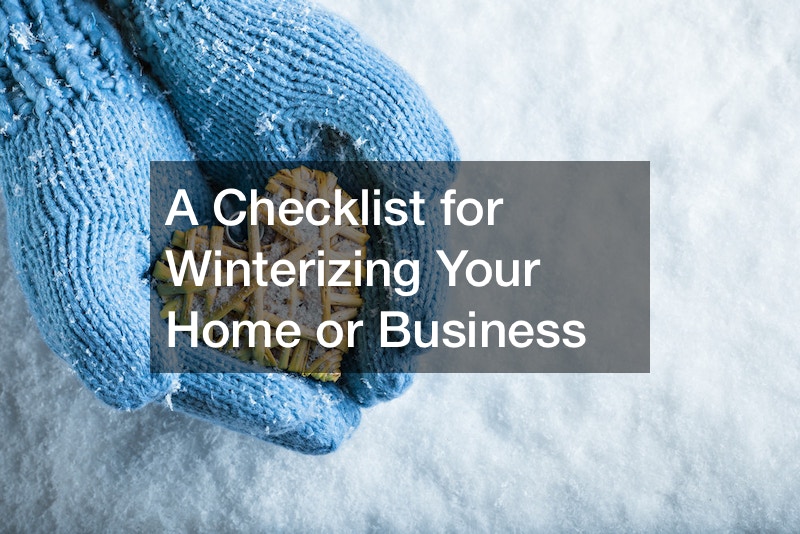

With winter here, it’s important to winterize your home or business so you can lower the risk of having to make expensive fixes. These may be necessitated by the effects of the harsh weather on your home or business building. Read on to see some helpful tips that should enable you to winterize your home or business effectively in this checklist for winterizing your home. Putting these steps in action should help you to brace for the winter and emerge through the other end with your property in good shape.
1. Make Sure You Have Road Salt

The first item in this checklist for winterizing your home is to make sure that you have road salt. You never know how extreme the weather may get and you can’t rule out the possibility that you may need to head out in the snow. That said, it’s a good idea to talk to a road salt supplier and get adequate amounts of road salt. When you have this, you’ll have an easier time making your way to where you need to be without having to rely on someone else to help clear the snow out of your path. You can simply spread the road salt on an icy patch on the road and melt it away to allow you passage. Remind your staff and family to also have this necessity as they never know when it may come in handy.
2. Ensure Your Land is Clear
The next item in this checklist for winterizing your home is to make sure that your land is clear. This means that you should start by getting all the outdoor equipment and furniture indoors. Next, clear out your yard of details that are easy to miss, like sprinklers and such. Finally, rake the dead leaves and debris from your landscape so that you can start the winter on a clean slate, so to speak. If this is a bit too demanding for you, then it’s a good idea for you to call a land clearing business to help you clear your land. Let them know what you need to be done and negotiate for a fair price and you’ll get clear land at a lot less hassle than doing it yourself. This will make the coming season stress-free and easy for you, since you may not have a lot of work to do in terms of preparing your landscape.
3. Be Prepared to Spend a Little More Money

Not to be left out of this checklist for winterizing your home is to set aside some money for the tasks that you need to get done. With a winterizing budget, you’re bound to have a much easier time doing what you need to do. In the event that you don’t have enough capital in the case of your business, you should seek out good investment lending services and talk to them to see how they can help. Even if you don’t have a business and simply want to winterize your home, you could get some financial assistance to do this if you look around. Consider winterizing your home or business an important part of protecting your investment. This is because if any damage comes to it, you’ll have to spend a lot of money to undo it. That said, leverage your good credit to get a loan for winterizing your home or approach unofficial money lenders. These may give you more reasonable terms than an official lender such as a bank would.
4. Upgrade Your Windows
The checklist for winterizing your home wouldn’t be complete if it didn’t include upgrading your windows. Start by performing a visual inspection to find out whether there’s any obvious damage to the windows in your home or business. If you find any cracks and gaps between the frame and the wall, then remedy it right away. You could either call a professional to fix the windows or head to your local hardware store and pick up some caulk. Use this to fix these gaps and cracks fast and easily, a solution that will last you through the winter. Alternatively, and if you can afford it, you may replace your windows altogether. Depending on the kind of windows that your home has, you may search online for something like vinyl window replacement. From the results, you’ll find quite a few experts in your area that can do a window replacement. Check their reviews and ask them for a quote of their services. This should enable you to know how much to set aside. This is the best solution so far because it will fix your windows for a long time to come.
5. Ensuring the Sides of Your Building are Protected
The next item in this checklist for winterizing your home is to make sure that your building is properly insulated. Even if you’ve fixed the windows, this isn’t enough. You have to check the walls to make sure that there aren’t any gaps in the siding. If you find any, then it’s a good idea for you to make a replacement as soon as possible. This is because these gaps can see your building losing treated air to the outdoors. This can cost you a significant amount of money in terms of energy bills. That said, you’re better off making sure that it’s out of the way. Once you’ve fixed issues with the siding, you need to check the insulation and ensure that it’s solid enough to keep the interior spaces nice and cozy even as the wind blows outside. If you have many doors and windows, as would be the case for a building, you should head to a local bulk windows and door store to get what you need. This will be more efficient and cost effective for you.
6. Upgrade Your Roof

Don’t forget to add upgrading your roof to this checklist for winterizing your home. Your roof helps keep your home or business safe from the extreme weather outdoors. As the first line of defense, it’s important to keep it in good shape throughout. This means that if you have a metal roof, you should call metal roofing services to do a thorough inspection of your roof. If there are any issues, then have them fixed right away. This can make a big difference in terms of the way in which your interior space feels. Leaving roof damage alone through the winter is practically living under a ticking time bomb. At any moment, the roof may fail and leave you and your family battling the cold and in desperate need of help. This help may not come cheap, all things considered, so make sure that your roof is in good shape for the winter.
7. Repave Your Driveways
Remember to also repave your driveways as part of your checklist for winterizing your home. This will not only keep your driveway looking amazing, but it will also help you to prevent additional damage from occurring. With the help of commercial pavers, you can easily have your driveways repaved for a smoother time this season. Some of the signs that should let you know that you need to repave your driveways include seeing cracks and potholes around your driveway, and if it’s been three to five years since you last had the driveway worked on. When it falls apart, it can take your foundation along with it and leave you having to foot a large bill for home maintenance. This makes the driveway an important element of your home to keep in good shape, especially in time for winter’s harsh conditions.
8. Ensuring Your Pipes Don’t Freeze
Few things can be as troublesome and annoying to a homeowner or business owner as frozen pipes. Shut off all external water flows and insulate piping for sprinklers and water features or bring it indoors so that you can avoid getting frozen pipes. These may get damaged extensively if ignored, potentially even needing to be replaced altogether. To avoid this, call your local plumbing service to help you make sure that your pipes are effectively winterized. They should also do an inspection and if anything’s found to be out of place, you should have it fixed as soon as possible. While doing this, don’t neglect smaller issues such as leaking taps and faucets. These may leave your home or business uncomfortable and unpleasant to be in. Since winter is a time for spending a lot of time indoors, it’s crucial that these small things all work well if you want to have an easy time.
9. Doing Any Last Minute Landscaping

Landscaping is another crucial item to add to your checklist for winterizing your home. If you have flowering trees and plants outdoors, bring them inside before the cold sets in. Doing this will keep them alive and ready to thrive come next season. For the plants that can’t be brought indoors, start by watering them deeply every week before the first hard freeze sets in. Don’t add fertilizer at this time because it will only lead to growth that won’t withstand the frost. Unless there are large trees or shrubs that have weak limbs which may fall on your property and cause damage, you should also avoid pruning. Last but not least, make sure to add mulch or similar landscaping products around the base of newly-planted trees and shrubs as well as sensitive perennial plants. This will help protect their roots from the low temperatures in winter. For the best outcome, apply organic mulch such as bark chips, pine needles, straw, compost, hay, or even leaves a few inches away from the plants. This will help avoid the possibility of rot as well as small rodents that seek shelter in the mulch chewing on the plants you’re trying to protect.
10. Servicing Your HVAC
Last but not least, take time to winterize your HVAC system. This will help it to function well and perhaps even save you money you’d have spent on energy during the winter. In this season, you’ll find that you rely heavily on your air conditioner, so it’s in your best interests to keep it in good shape throughout. For the internal part of the HVAC, change the air filters and install a programmable thermostat if you don’t already have one. Doing this is going to help you lower your energy costs in winter as your unit will run much more effectively. As for the outdoor unit, remove any debris that you find stuck on it including trash, grass clippings, and leaves. Next, cover it with a sheet of plywood so that no additional debris can get into it during winter, including small rodents seeking shelter from the biting cold. You could also add a layer of wax to the unit’s surface from the harsh weather that winter is bound to bring. During the winter, remove any snow on the surface of the condenser so that there’s no additional weight on the unit or a chance that the protection you’ve placed on the unit will move.
Use this checklist for winterizing your home to make sure that you’re ready, come what may. When you do this, it may be easier for you to maintain a functional and comfortable home or business space throughout the year. This is because you’ll not have additional issues to deal with when the new season comes. You’ll simply need to prepare your space for the new season, starting on a fresh, new slate that doesn’t need a lot of work done on it. Do your best to tick every item on this list so that you can stay safe from the possibilities of destruction to your home or business, even if minor.



